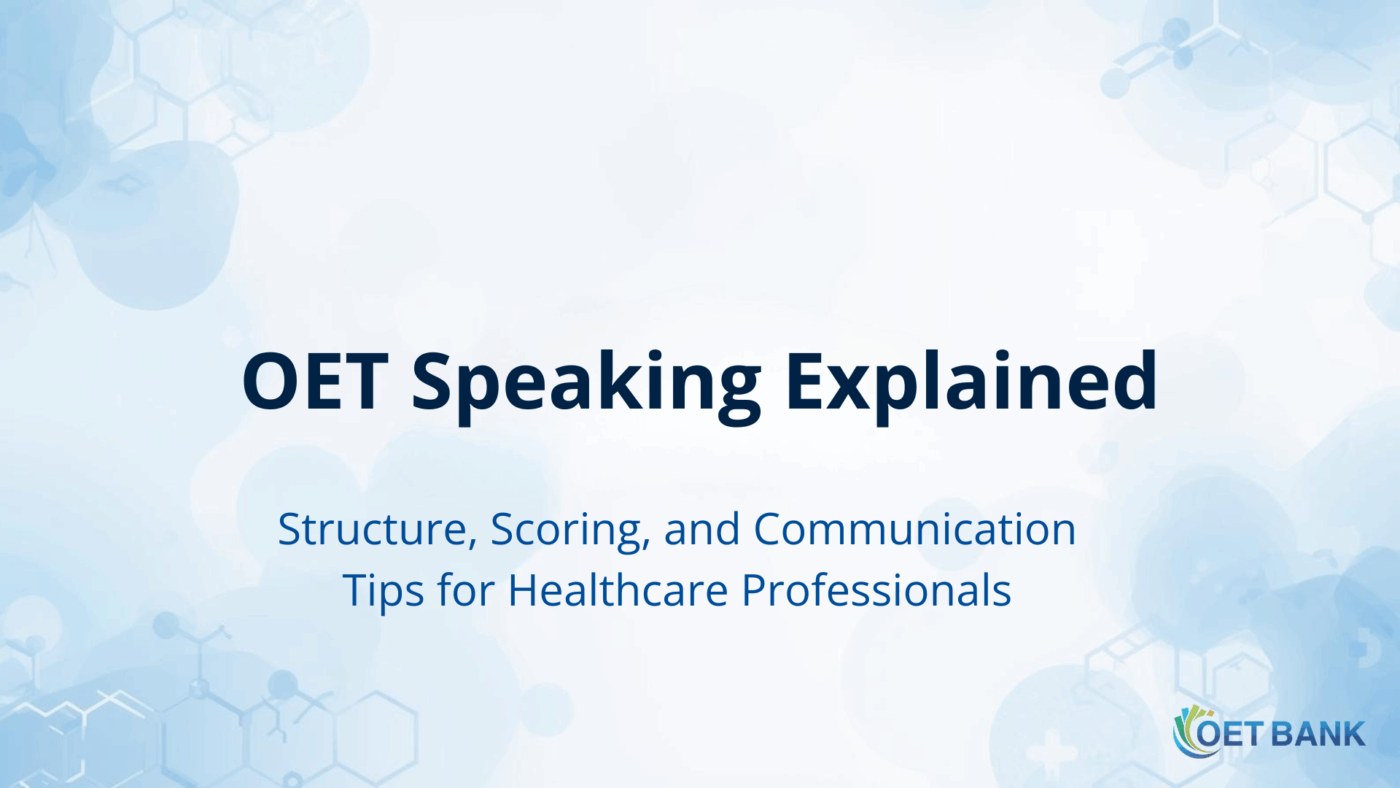Listening, OET Strategies, Speaking
OET Speaking Explained: Structure, Scoring, and Communication Tips
If you’ve ever practiced for the OET Speaking test, you probably know that it’s not just about grammar or pronunciation. You can sound fluent — and still lose marks if your conversation doesn’t feel natural or empathetic.
In this article, we’ll walk through what really happens in the test — how it’s structured, how you’re scored, and what kind of communication makes the biggest difference.
OET Speaking Overview
The OET Speaking sub-test lasts about 20 minutes, consisting of two role-plays (each 5 minutes long, with 3 minutes of preparation time).
You’ll interact with an interlocutor who plays the role of a patient (or occasionally a patient’s relative). Your goal is to manage the consultation as naturally as possible — just as you would in a real clinical setting.
Before each role-play, you receive a role-play card describing the situation: the patient’s condition, symptoms, and key communication tasks. During the 3-minute prep time, you’ll organize your thoughts and plan the structure of the consultation.
A distinctive feature of the OET Speaking test is that it’s assessed from two perspectives.
Evaluation Criteria
You’re graded on two main dimensions:
- Linguistic Criteria (language accuracy and fluency)
- Clinical Communication Criteria (consultation and interaction skills)
Among these, the Clinical Communication Criteria carry major weight — mastering this area is essential for achieving a high score.
The five aspects of Clinical Communication are:
- Relationship-building – establishing trust and rapport
- Understanding and incorporating – showing empathy and responding to patient concerns
- Providing structure – keeping the consultation organized
- Information-gathering – eliciting relevant medical information
- Information-giving – explaining clearly in layman’s terms
Notably, rapport with the patient is heavily emphasized.
Unlike a rapid-fire clinical exam, the OET Speaking test rewards communication that feels empathetic and supportive — more like a calm counseling session than a quick diagnosis.
Typical Structure of an Ideal OET Role-Play
Based on the criteria above, a well-structured OET Speaking role-play generally follows this flow:
- Greeting / Relationship-building
- History-taking (Information-gathering)
- Explanation (Information-giving)
- Summary / Confirmation
1. Greeting
Begin the consultation warmly — aim for the impression of a friendly, caring doctor.
For example:
I’m Dr _____.
Could I have your name, please?
Feel free to ask questions anytime if you have any concerns, okay?
So, what brought you here today?
These small openings help establish rapport before you move into the main discussion.
Since the test is recorded, make sure such positive language appears in your speech.
2. History-taking
Once the patient starts describing their symptoms, move into information-gathering.
Even if the role-play card contains detailed tasks, never skip this step — otherwise, you’ll miss marks under “Information-gathering.”
Start broadly, then narrow your questions:
How do you feel now?
→ Do you have any pain or discomfort in your ____?
→ When did it start?
Aim for 2–3 focused questions before shifting to explanation, so you have enough time for the rest of the conversation.
3. Explanation
Now address the clinical issue using the information from the role-play card.
This section varies depending on the scenario, so prior exposure to common symptoms and treatments is invaluable.
Your explanation should include:
- Overview – summary of the condition
- Cause – what’s happening physiologically
- Treatment – management or advice
- Side effects / precautions – explained in simple terms
Avoid overly technical words; instead, use language any layperson — even an elderly patient — could understand.
4. Summary and Confirmation
Conclude by summarizing what you discussed and checking the patient’s understanding:
Okay?
Do you have any questions?
Any concerns?
You don’t need to repeat everything; concise reassurance and confirmation demonstrate empathy and professionalism.
Scoring Tips
Beyond mastering the structure, one crucial habit is using empathetic phrases that acknowledge the patient’s emotions.
In almost every OET scenario, the patient feels anxious or worried. Show that you recognize those feelings.
Follow the rhythm:
Patient speaks → You empathize → You move to the next topic.
Here are some effective examples to memorize:
- I’m sorry to hear that.
- That’s hard. Are you okay now?
- I can understand your concerns.
- That must be distressing for you.
Practicing these expressions until they sound natural will make your communication more human — and your score more stable.
Conclusion
To succeed in OET Speaking, you must understand what the exam truly evaluates.
Once you grasp those criteria, you’ll find that consistent high scores come naturally — even without endless speaking practice.
Before jumping into pronunciation drills or online conversation lessons, spend time mastering the skills that the test actually measures.
If you’re preparing for OET, consider exploring our practice resources at OET Bank.
We’re designed not just as mock tests, but as powerful review tools that make it easier to analyze weaknesses and focus on what’s needed to pass.
Explore professional learning materials and courses:


